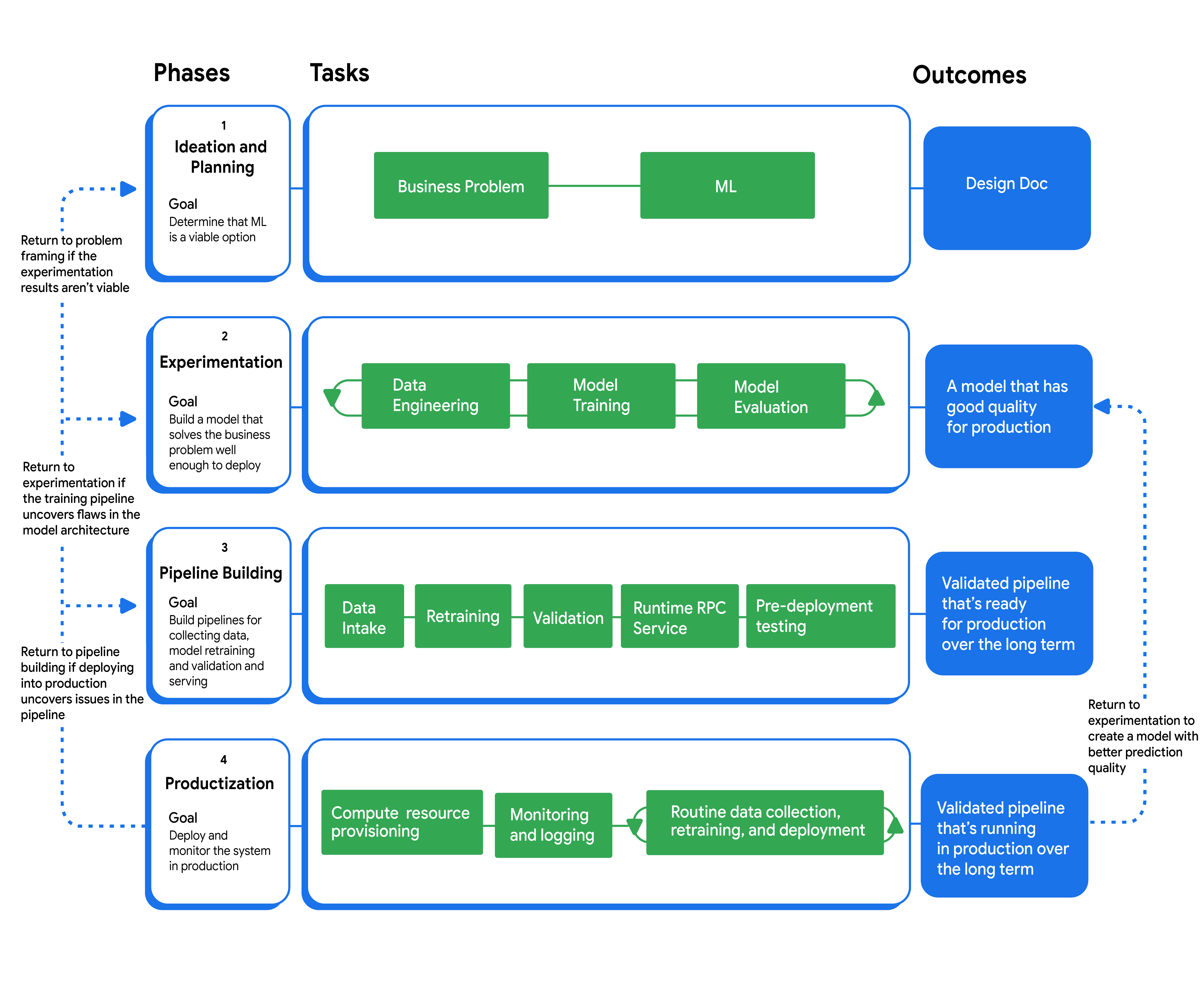پروژه های ML در مراحلی با اهداف، وظایف و نتایج خاص پیشرفت می کنند. درک واضح از مراحل توسعه ML به ایجاد مسئولیت های مهندسی، مدیریت انتظارات ذینفعان و تخصیص کارآمد منابع کمک می کند.
حرکت موفقیت آمیز در مراحل (اغلب به صورت تکراری) برای طراحی، مونتاژ و ساخت مدل های ML که مشکلات تجاری را در دراز مدت حل می کند، اساسی است.
در سطح بالا، پیاده سازی راه حل ML شامل مراحل زیر است:
- ایده پردازی و برنامه ریزی
- آزمایش
- ساختمان خط لوله
- تولید
ایده پردازی و برنامه ریزی
در مرحله ایدهپردازی و برنامهریزی، شما مشکل خود را بر اساس راهحل ML تنظیم میکنید و امکانسنجی پروژه را برآورد میکنید.
- هدف : تعیین اینکه آیا ML بهترین راه حل برای مشکل شما است یا خیر.
- وظایف : برای درک محدودیت های پروژه خود، مشکل کسب و کار را تجزیه و تحلیل کنید.
- نتیجه : یک سند طراحی که چگونگی حل یک مشکل با راه حل ML را تشریح می کند.
آزمایش
آزمایش هسته یادگیری ماشینی است. در طول این مرحله، شما تأیید می کنید که یک راه حل ML قابل اجرا است. یافتن راه حل یک فرآیند تکراری است. غیر معمول نیست که صدها آزمایش را قبل از یافتن ترکیب مناسبی از ویژگی ها ، ابرپارامترها و معماری مدل که مشکل را حل می کند، امتحان کنید.
- هدف : ساخت مدلی که مشکل کسب و کار را حل کند.
- وظایف : با ویژگیها، ابرپارامترها و معماریهای مدل آزمایش کنید.
- نتیجه : مدلی با کیفیت کافی برای تولید.
ساخت و تولید خط لوله
در طول مرحله ساخت و تولید خط لوله ، شما خطوط لوله را برای پردازش داده ها، آموزش یک مدل و ارائه پیش بینی ها می سازید. سپس مدل و خطوط لوله را با زیرساخت نظارت و ثبت گزارش لازم وارد تولید میکنید.
- هدف : ایجاد و پیادهسازی زیرساخت برای مقیاسبندی، نظارت و نگهداری مدلها در تولید.
- وظایف : خطوط لوله بسازید تا بسیاری از وظایف را برای به روز نگه داشتن مدل ها در تولید به طور خودکار انجام دهید.
- نتایج : خطوط لوله ML معتبر.
گردش کار ML سرتاسر
نمودار زیر کل گردش کار ML انتها به انتها را نشان می دهد و هر مرحله و وظایف و نتایج آن را فهرست می کند:

شکل 1 . چهار مرحله اصلی گردش کار ML.
در نظر داشته باشید
چالش های متعدد در هر مرحله وجود دارد. عدم درک و برنامه ریزی برای آنها ممکن است منجر به از دست رفتن ضرب الاجل، مهندسان ناامید و پروژه های شکست خورده شود.
